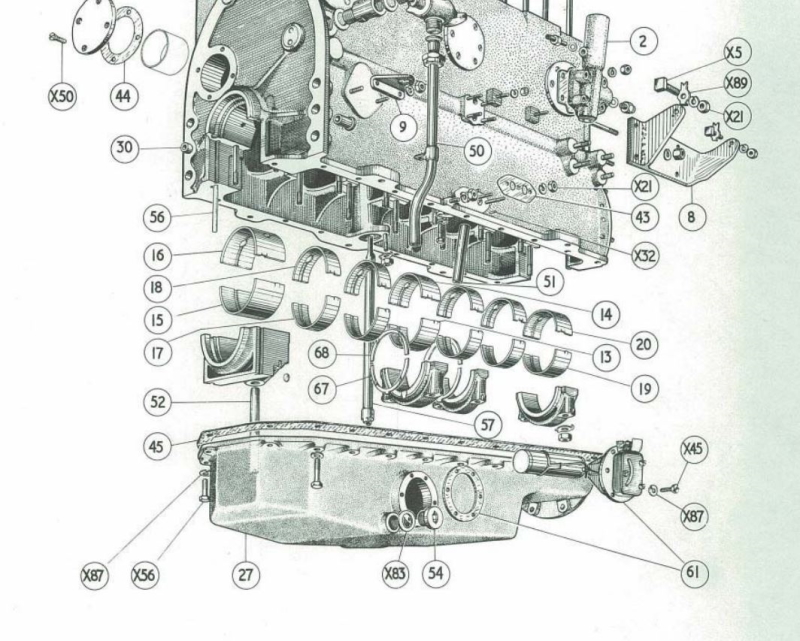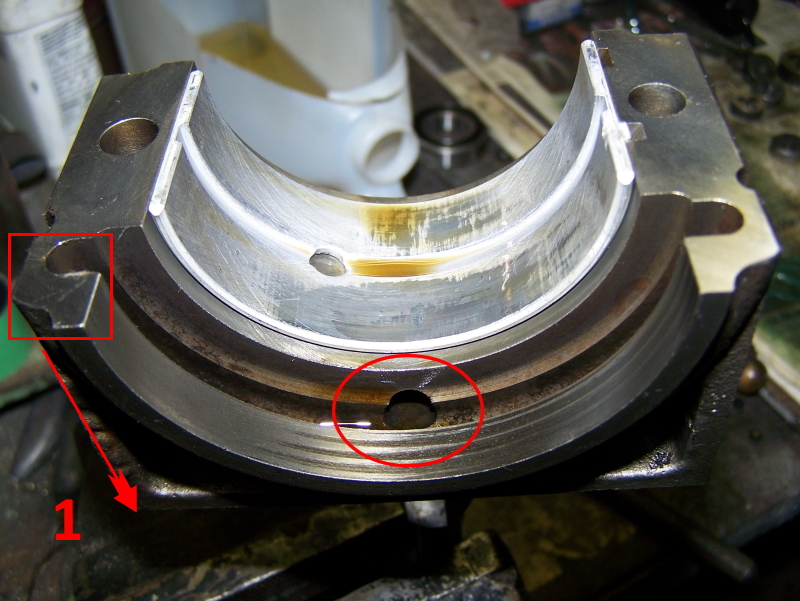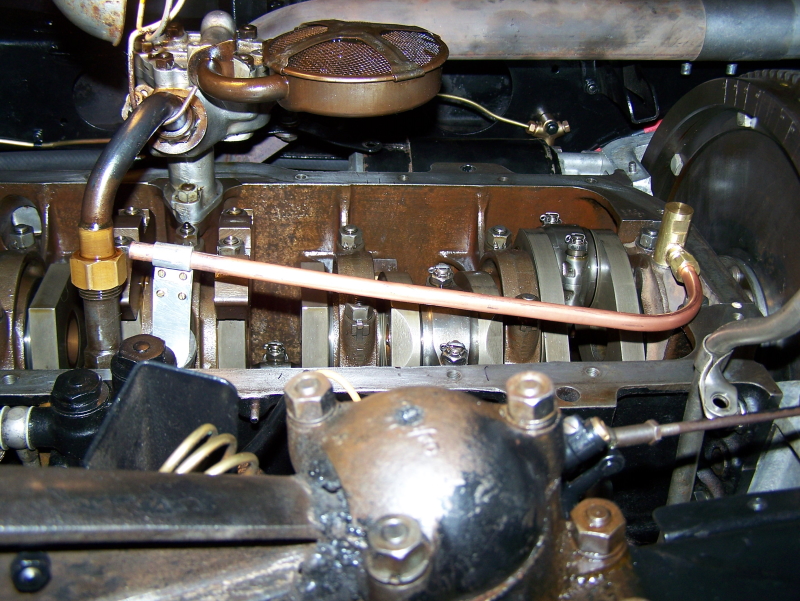| Author | Message | ||
Paul Unregistered guest Posted From: 46.11.122.112 |
Hi, i have a leak coming from the rear of engine, exactly from the crankshaft oil seal. this straight six engine takes 2 wooden dowel as oil seal. can some one tell me if i have to remove the crankshaft completely to change these dowels or just the crank case please? thanks (Message approved by david_gore) | ||
NORMAN GEESON Unregistered guest Posted From: 82.6.223.129 |
Paul I am afraid you are unlikely to have any luck by trying to change the wooden dowels. These are only secondary seals to the sides of the rear main bearing cap. The actual crankshaft sealing arrangement is via a reverse scroll on the crankshaft acting within the bore of the main cap and crankcase. This is not a positive sealing arrangement and is usually overcome by excessive crankcase pressure, or overfilling with oil. Excessive pressure is generated by general engine wear, poor rings and worn/seized pistons etc. You also need to be aware that if the oil level is kept up to the full mark then the slightest road incline will result in either No.1 or No. 6 con rod contacting the oil. A front nose down position of more than 10 degrees will even have the timing gears running submerged, according to R-R. In practice you will find the most advantageous situation is to mark the oil dip stick between the half way and full position and use this three quarters mark as the absolute full oil position. Some 50 years ago I was engaged in running these cars across Switzerland and we had to remark all our oil dip sticks, using the aforementioned criteria. Today I still use a lower oil level dip stick marking on my own car, which I allow to run down to the half way mark if required. This engine has deliberately more piston clearance, and more crankcase compression than usual. Yet in 5000 miles in the last 3 months, running in three countries, returns 750 mile per pint and does not leak excessively from the rear scroll seal. (Message approved by david_gore) | ||
Richard Treacy Grand Master Username: richard_treacy Post Number: 2907 Registered: 4-2003 |
Just to supplement Norman's note, the dowels can be easily replaced although as pointed out they are rarely an issue. With the sump removed, a 20 minute job, the rear main bearing cap can be removed to clear out the old dowel. With the bearing cap refitted, the new dowels are driven in. RT. ps: as my R-Type does no tunnel trips trickier than the Sydney Harbour Tunnel, it does not suffer the Gotthard effect that Norman describes. Since 1980 it has had positive valve stem seals, along with more modern pistons and rings than original, so oil consumption and leakage are zero. The level does not drop from the original Full mark at all between changes by more than 1mm. | ||
Bob uk Unregistered guest Posted From: 94.197.122.77 |
Gate crasher from sy land Dip stick marks mean keep oil.somewhere between the marks not keep oil at max Engines burn oil so there is.extra capacity to allow for his so a good distance can be covered and then topped up. The driver may want only to go to half way because short trips only the same as petrol It is fine to run half way Keep engine breather clean Would vacuum work A 4.8 Dawn is my favourite RR (Message approved by david_gore) | ||
Randy Roberson Prolific User Username: wascator Post Number: 234 Registered: 5-2009 |
Some of our guys would keep a little vacuum on their large engines' crankcases to reduce leaks and it did work, but because we feared creating an explosive mixture in the crankcase (air + fuel, you know...) we had to stop it. Some engines even came from their makers with a vacuum arrangement using the intake. | ||
Bob uk Unregistered guest Posted From: 94.197.122.83 |
Use flame traps from Rover V8 They are small tube to tube fitted I once made a replacement crank case door for a big diesel ship to ssuit a mangled up one the blew off it was 10mm thick it was nearly bent double The ships engineer said the explosion knocked him over and he felt lucky to be alive So I understand your concerns (Message approved by david_gore) | ||
Jeff Martin Frequent User Username: jeff_r_1 Post Number: 407 Registered: 07-2018 |
Chasing down oil leaks and there is still one happening at the back of the sump, and this thread makes sense as to where the oil is coming from. Not a huge amount, but enough to make a mess over a time and get all over the servo. I drove the Malahat, a small clime in my area about 10km long with an average of 3.1% grade, with a summit of 1168 feet above sea level, not that steep, although I'm guessing the steepest part at 5% _ hard to say. What is pipe #52 doing, if anything that is the problem; it drains from the reverse spiral into a tiny reservoir in the sump. From what I can see, when the oil in the pan is nearing the max amount on the dip stick, any oil that's forced to the back of the sump from climbing a step hill, blocks the pipe. This causes the reverse spiral to become overwhelmed with oil from the rear main bearing and it pukes out the back of the engine. The solution as I see it is to redirect the pipe and shorten it to the centre of the sump, or even better, just get rid of it, or leave it where it is and shorten it. Just let any excess oil drip from the spiral into the pan, what does it need the pipe for ? Looking at things, once the pipe is removed, the car would have to be at quite the angle for any oil to over-come the spiral. The spiral is quite high in the crank case, once the pipe is removed, that should solve the problem. Another thing, how come there is no oil splash baffle on this engine to keep the oil in the sump from foaming up ? Even with the sump pick up, floating on top of the oil, I would think there would be enough "foamed up" oil to allow air to get into the pumps pick-up. I'm seriously thinking of adding one.  | ||
Jeff Martin Frequent User Username: jeff_r_1 Post Number: 409 Registered: 07-2018 |
Having removed the rear main bearing cap, I've discovered the only oil it sees is coming from the rear main bearing, it sees no other oil. Any other oil from the sump comes up against the bearing and cap from "that" side and does not affect the scroll. What's wrong is the poor placement of the drain tube "52" which becomes submerged when driving up a steep hill and the oil from the scroll can't escape. The oil backs up and oddly enough does not come out of the front of the scroll area, but where the bearing cap meats the block; see red rectangle in the photo. It escapes well past the wood dowels. It then proceeds down the outside edge of the bearing cap and runs along the pan gasket area, giving the illusion that the pan gasket is leaking, when in fact it isn't. One can't put sealant here as this will adversely affect the bearing clearance. I plan on having that small area machined down so I can glue a small gasket in there, although once I reroute the drain tube to the middle of the sump, there should be very little oil here to worry about, but I still may proceed. RR should have moved the dowels nearer to the edge of the bearing cap to seal the entire area off. I'll take a few more photos of the rerouted drain pipe when that job is done.  | ||
Jeff Martin Frequent User Username: jeff_r_1 Post Number: 420 Registered: 07-2018 |
Here's the finished job, I initially used a 1/2 compression elbow, but the copper tubing ended up being too low coming out of the bottom of the bearing cap. I wanted as much slant on it, so it would be level when climbing a hill, in the end there will be some back pressure on the spiral when climbing very steep hills, but that amount of oil is only what's coming from that side of the rear main bearing. That's still better than the entire contents of the sump, keeping the oil from escaping from the spiral. I took the car for a spin on this winding and hilly road, and so far so good. The most time-consuming part of the job was making the junction that comes out of the bearing cap. The engine is nice and tight with it's modern pistons and rings, so I don't believe that any crank-case pressure is going to affect the spiral, if it does, there is a port with an aluminum cover on it just where the dip stick is where I can add another breather if need be. I suspect that's why RR did that thing with the little reservoir to keep the crank-case pressure off the spiral, but having it drain at the back of the sump, was an engineering mistake IMO. | ||
Jeff Martin Frequent User Username: jeff_r_1 Post Number: 421 Registered: 07-2018 |
 | ||
Bill Vatter Experienced User Username: bill_vatter Post Number: 150 Registered: 09-2004 |
Hmmmmm. I wonder why my engines don't leak oil also. I don't have the re-located drain for the seal. I also wonder why RR had a drain pipe from the seal to a secondary sump that causes the pipe to be continually submerged in oil. Hmmmmm again. You may have fixed something that wasn't broken, and in doing so, made the situation worse. Just say'n. | ||
Jeff Martin Frequent User Username: jeff_r_1 Post Number: 422 Registered: 07-2018 |
Mine was always an oily mess back there _ I stand by my fix, it's not going to hurt anything. If you look at Photo 1 in my second post (the red box), I think that was the main problem on mine. I did put some pressure sensitive sealant there after speaking to my machinist, apparently that is common to add some in that spot and it would not affect the clearance of the rear main bearing. I like to run a higher sump oil level, not right to the full mark, but a couple of CM from the top, hence my pipe. Why did RR have the drainpipe immersed in it's own secondary sump, was it to reduce crank case pressure on the rear spiral ? (not rhetorical) How would it have made the situation worse, your post isn't very helpful ? RR is not the end-all beat-all of engineering, they themselves make improvements as they go along, correcting their mistakes down the line, eg, the straight 6 engine from the 4.25 to the 4.9, the combustion chamber being one of them. No I'm not engineer, but like some of us here, I can look at a design and wonder why they did that; that doesn't make sense _ better this way. That's good that yours doesn't leak, mine did, and now it doesn't, at least so far. Note that the photo is up-side-down so it's easy to look at. The diversion pipe is actually pointing down towards the sump, the oil runs down-hill, not against gravity. | ||
Jeff Martin Frequent User Username: jeff_r_1 Post Number: 423 Registered: 07-2018 |
Here's the way it's supposed to look, the end of the pipe is just immersed in oil if it was filled to highest mark on the dip stick. The idea is to keep the oil out of the pipe so it doesn't back-up into the spiral. I don't see how this can make things worse ???  |